Differences between Qualitative and Quantitative Research Methods
VerifiedAdded on 2022/12/19
|9
|2515
|66
Report
AI Summary
This report provides a comparative analysis of qualitative and quantitative research methods within the context of social sciences. It begins by outlining the fundamental differences in research philosophies, specifically positivism and interpretivism, and their influence on research choices. The report then delves into the methodologies employed in each approach, highlighting the use of surveys, questionnaires, and deductive approaches in quantitative research, and exploratory methods and interpretivism in qualitative research. The report emphasizes the differences in sample size and data collection methods, explaining how these variations impact the gathering of data and the drawing of conclusions. Furthermore, the report examines key arguments from quantitative articles related to the COVID-19 pandemic's impact on mental health, including studies on undergraduate and graduate students, and the perceptions of social distancing. The conclusion summarizes the key differences and applications of these methods, providing a comprehensive understanding of their respective strengths and weaknesses.
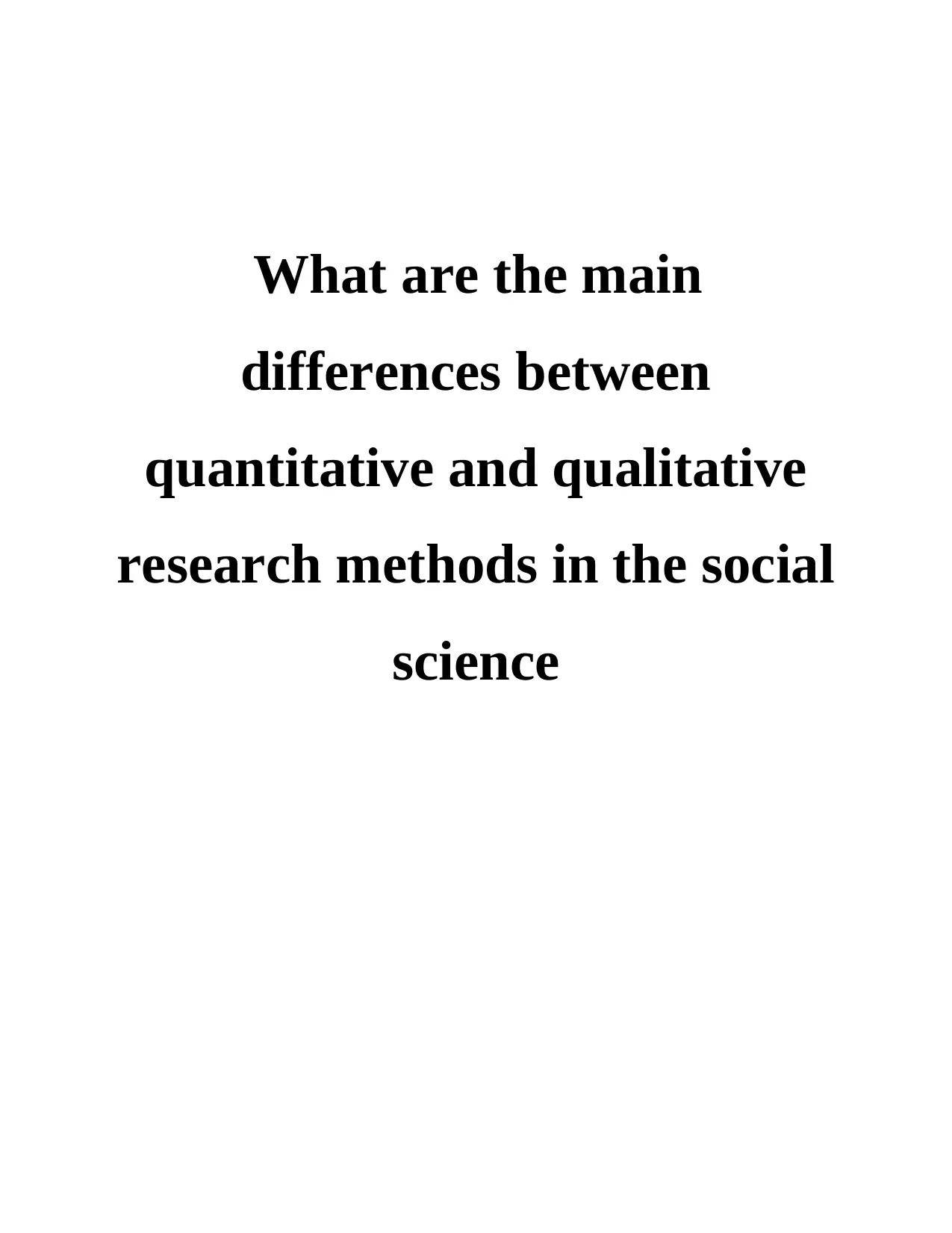
What are the main
differences between
quantitative and qualitative
research methods in the social
science
differences between
quantitative and qualitative
research methods in the social
science
Paraphrase This Document
Need a fresh take? Get an instant paraphrase of this document with our AI Paraphraser
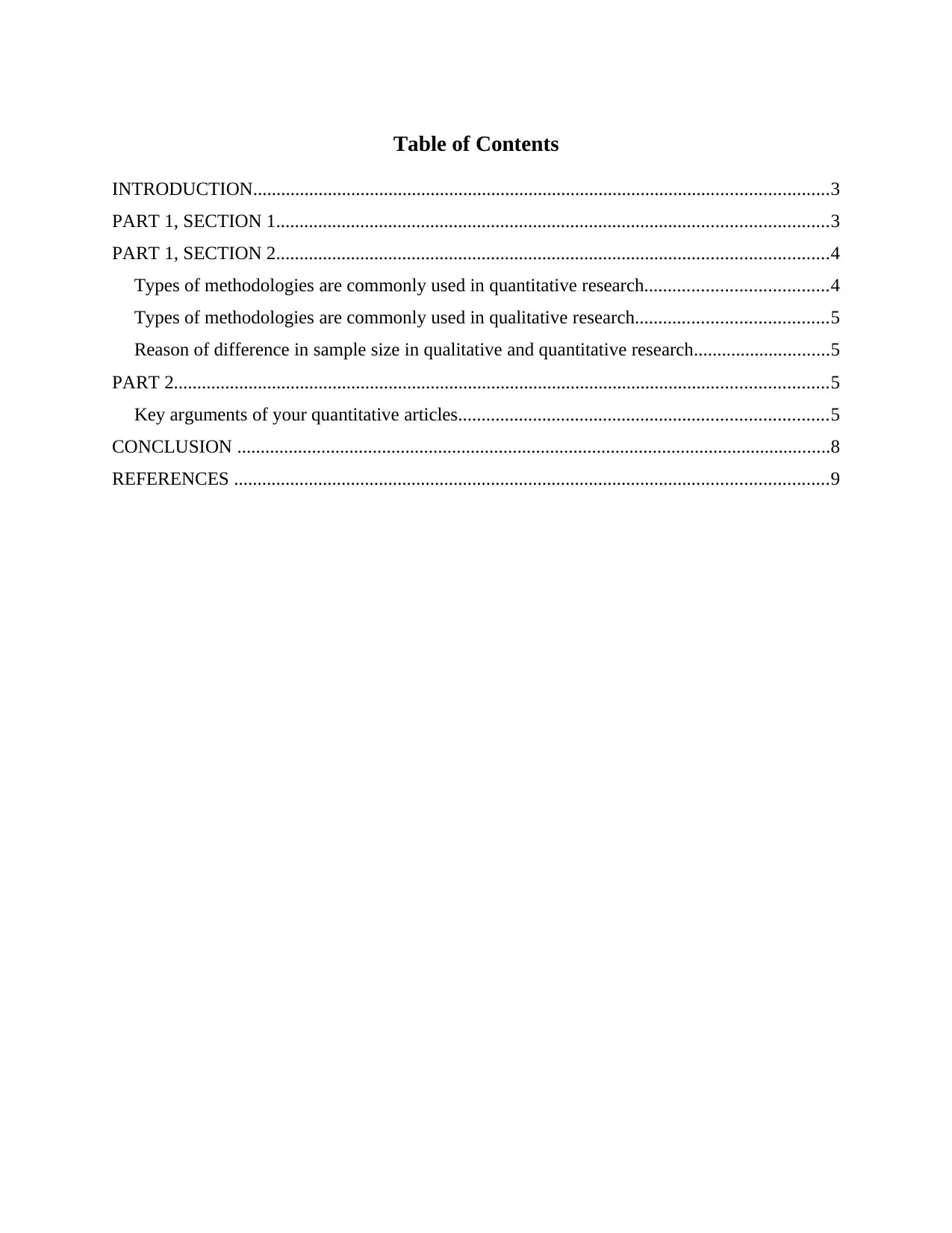
Table of Contents
INTRODUCTION...........................................................................................................................3
PART 1, SECTION 1......................................................................................................................3
PART 1, SECTION 2......................................................................................................................4
Types of methodologies are commonly used in quantitative research.......................................4
Types of methodologies are commonly used in qualitative research.........................................5
Reason of difference in sample size in qualitative and quantitative research.............................5
PART 2............................................................................................................................................5
Key arguments of your quantitative articles...............................................................................5
CONCLUSION ...............................................................................................................................8
REFERENCES ...............................................................................................................................9
INTRODUCTION...........................................................................................................................3
PART 1, SECTION 1......................................................................................................................3
PART 1, SECTION 2......................................................................................................................4
Types of methodologies are commonly used in quantitative research.......................................4
Types of methodologies are commonly used in qualitative research.........................................5
Reason of difference in sample size in qualitative and quantitative research.............................5
PART 2............................................................................................................................................5
Key arguments of your quantitative articles...............................................................................5
CONCLUSION ...............................................................................................................................8
REFERENCES ...............................................................................................................................9
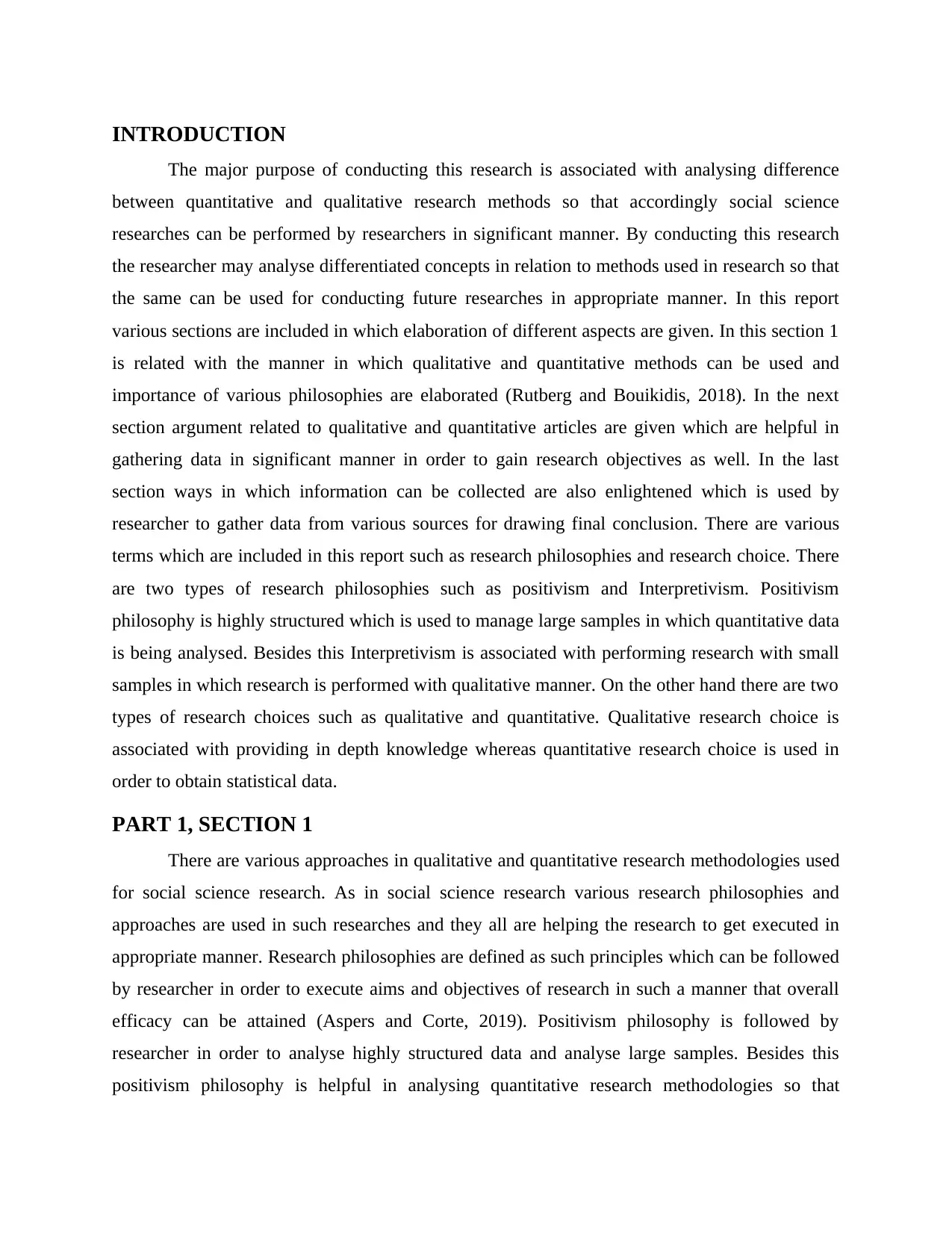
INTRODUCTION
The major purpose of conducting this research is associated with analysing difference
between quantitative and qualitative research methods so that accordingly social science
researches can be performed by researchers in significant manner. By conducting this research
the researcher may analyse differentiated concepts in relation to methods used in research so that
the same can be used for conducting future researches in appropriate manner. In this report
various sections are included in which elaboration of different aspects are given. In this section 1
is related with the manner in which qualitative and quantitative methods can be used and
importance of various philosophies are elaborated (Rutberg and Bouikidis, 2018). In the next
section argument related to qualitative and quantitative articles are given which are helpful in
gathering data in significant manner in order to gain research objectives as well. In the last
section ways in which information can be collected are also enlightened which is used by
researcher to gather data from various sources for drawing final conclusion. There are various
terms which are included in this report such as research philosophies and research choice. There
are two types of research philosophies such as positivism and Interpretivism. Positivism
philosophy is highly structured which is used to manage large samples in which quantitative data
is being analysed. Besides this Interpretivism is associated with performing research with small
samples in which research is performed with qualitative manner. On the other hand there are two
types of research choices such as qualitative and quantitative. Qualitative research choice is
associated with providing in depth knowledge whereas quantitative research choice is used in
order to obtain statistical data.
PART 1, SECTION 1
There are various approaches in qualitative and quantitative research methodologies used
for social science research. As in social science research various research philosophies and
approaches are used in such researches and they all are helping the research to get executed in
appropriate manner. Research philosophies are defined as such principles which can be followed
by researcher in order to execute aims and objectives of research in such a manner that overall
efficacy can be attained (Aspers and Corte, 2019). Positivism philosophy is followed by
researcher in order to analyse highly structured data and analyse large samples. Besides this
positivism philosophy is helpful in analysing quantitative research methodologies so that
The major purpose of conducting this research is associated with analysing difference
between quantitative and qualitative research methods so that accordingly social science
researches can be performed by researchers in significant manner. By conducting this research
the researcher may analyse differentiated concepts in relation to methods used in research so that
the same can be used for conducting future researches in appropriate manner. In this report
various sections are included in which elaboration of different aspects are given. In this section 1
is related with the manner in which qualitative and quantitative methods can be used and
importance of various philosophies are elaborated (Rutberg and Bouikidis, 2018). In the next
section argument related to qualitative and quantitative articles are given which are helpful in
gathering data in significant manner in order to gain research objectives as well. In the last
section ways in which information can be collected are also enlightened which is used by
researcher to gather data from various sources for drawing final conclusion. There are various
terms which are included in this report such as research philosophies and research choice. There
are two types of research philosophies such as positivism and Interpretivism. Positivism
philosophy is highly structured which is used to manage large samples in which quantitative data
is being analysed. Besides this Interpretivism is associated with performing research with small
samples in which research is performed with qualitative manner. On the other hand there are two
types of research choices such as qualitative and quantitative. Qualitative research choice is
associated with providing in depth knowledge whereas quantitative research choice is used in
order to obtain statistical data.
PART 1, SECTION 1
There are various approaches in qualitative and quantitative research methodologies used
for social science research. As in social science research various research philosophies and
approaches are used in such researches and they all are helping the research to get executed in
appropriate manner. Research philosophies are defined as such principles which can be followed
by researcher in order to execute aims and objectives of research in such a manner that overall
efficacy can be attained (Aspers and Corte, 2019). Positivism philosophy is followed by
researcher in order to analyse highly structured data and analyse large samples. Besides this
positivism philosophy is helpful in analysing quantitative research methodologies so that
⊘ This is a preview!⊘
Do you want full access?
Subscribe today to unlock all pages.

Trusted by 1+ million students worldwide

researches within social science aspect can be completed. On the other hand Interpretivism
research philosophy is _1616245619guiding researcher to attain their aims and objectives. In
Interpretivism research philosophy small samples are analysed due to which in depth
investigation can be performed which may lead in reaching to such research objectives in
significant manner (Hennink, Hutter and Bailey, 2020). As according to research nature
theoretical frameworks are used which are impacting the overall research in significant manner.
In quantitative and qualitative research, various differential methodologies are used as both these
researches are way different from each other hence according to research aim and nature these
can be selected. Subjective approach is used by qualitative research as this is associated with in
depth study due to which understanding of human and social science can be performed in
effective manner. Whereas quantitative research is associated with objective approach as in this
various people are taken with views and differentiated views can be gathered.
PART 1, SECTION 2
Qualitative and quantitative research are way different to each other as they both are
associated with differential aspects of research along with different approaches as well.
Methodologies used in qualitative and quantitative research is different from each other as in
quantitative research diversified information is collected whereas in qualitative research, in depth
analysis is being performed.
Types of methodologies are commonly used in quantitative research
In quantitative research different methodologies are used as the study within quantitative
research is used in order to take diversified information. Using survey method or questionnaire
qualitative research can be performed as in context of attaining research objectives within social
science research (Collingridge and Gantt, 2019). In quantitative research deductive approach is
being used as this approach leads in formation of some particular research aims. On the other and
data in quantitative data is measurable due to which result oriented information can be collected
by gathering numerical data. There are various methods used in quantitative research such as
surveys, questionnaire and observations so as according to need of research social science
research can be performed in effective manner. Quantitative research is using positivism research
philosophy as this philosophy is linked with analysing statistical results in appropriate manner.
Random sampling is the method of sampling used in quantitative research as in large population
research philosophy is _1616245619guiding researcher to attain their aims and objectives. In
Interpretivism research philosophy small samples are analysed due to which in depth
investigation can be performed which may lead in reaching to such research objectives in
significant manner (Hennink, Hutter and Bailey, 2020). As according to research nature
theoretical frameworks are used which are impacting the overall research in significant manner.
In quantitative and qualitative research, various differential methodologies are used as both these
researches are way different from each other hence according to research aim and nature these
can be selected. Subjective approach is used by qualitative research as this is associated with in
depth study due to which understanding of human and social science can be performed in
effective manner. Whereas quantitative research is associated with objective approach as in this
various people are taken with views and differentiated views can be gathered.
PART 1, SECTION 2
Qualitative and quantitative research are way different to each other as they both are
associated with differential aspects of research along with different approaches as well.
Methodologies used in qualitative and quantitative research is different from each other as in
quantitative research diversified information is collected whereas in qualitative research, in depth
analysis is being performed.
Types of methodologies are commonly used in quantitative research
In quantitative research different methodologies are used as the study within quantitative
research is used in order to take diversified information. Using survey method or questionnaire
qualitative research can be performed as in context of attaining research objectives within social
science research (Collingridge and Gantt, 2019). In quantitative research deductive approach is
being used as this approach leads in formation of some particular research aims. On the other and
data in quantitative data is measurable due to which result oriented information can be collected
by gathering numerical data. There are various methods used in quantitative research such as
surveys, questionnaire and observations so as according to need of research social science
research can be performed in effective manner. Quantitative research is using positivism research
philosophy as this philosophy is linked with analysing statistical results in appropriate manner.
Random sampling is the method of sampling used in quantitative research as in large population
Paraphrase This Document
Need a fresh take? Get an instant paraphrase of this document with our AI Paraphraser

the research can be performed in order to gather apt results which are aligned with research aims
in direct manner.
Types of methodologies are commonly used in qualitative research
Qualitative research method is associated with in depth study of research topic so there
are different methodologies used within this type of social research. Exploratory is the type of
research which is used within qualitative research as subjective information is gathered within
this research in which verbal data can be collected (Tenny and et. al., 2020). In terms of
philosophy, qualitative research is using Interpretivism philosophy as this is linked with
analysing data in depth manner so that to reach out to research objectives in clear manner.
Besides this verbal data is gathered in qualitative research as the overall research is process
oriented and leads to draw conclusion via words, objects and pictures. Methods used in
qualitative research are non structured in which interviews, discussions are included so that
initial understanding related to research topic can be developed. The objective of qualitative
research is to gather in depth information and knowledge in such a way that holistic results can
be obtained.
Reason of difference in sample size in qualitative and quantitative research
Sample size of qualitative and quantitative research are different as with same sample
size both the types of researches cannot be performed. In quantitative research major methods
used to gather data is interviews or surveys in which various respondents can be included and
align to get research results. In quantitative research large sample size can be added as this
research as this makes the researcher to get views of various respondents in such a way that
appropriate findings can be obtained with the help of statistical representation. Chances of
prominence and accuracy is more when quantitative research is performed as obtaining views of
various respondents will help the researcher to get apt conclusion related to research objectives.
Besides this in terms of qualitative research lesser number of respondents are collected as this is
a difficult task to bifurcate views of every single respondents (Flick, 2018). So in terms of
qualitative research sample size is small which leads the research to draw significant results.
PART 2
Key arguments of your quantitative articles
Undergraduate and Graduate Students’ Mental Health During the COVID-19 Pandemic
in direct manner.
Types of methodologies are commonly used in qualitative research
Qualitative research method is associated with in depth study of research topic so there
are different methodologies used within this type of social research. Exploratory is the type of
research which is used within qualitative research as subjective information is gathered within
this research in which verbal data can be collected (Tenny and et. al., 2020). In terms of
philosophy, qualitative research is using Interpretivism philosophy as this is linked with
analysing data in depth manner so that to reach out to research objectives in clear manner.
Besides this verbal data is gathered in qualitative research as the overall research is process
oriented and leads to draw conclusion via words, objects and pictures. Methods used in
qualitative research are non structured in which interviews, discussions are included so that
initial understanding related to research topic can be developed. The objective of qualitative
research is to gather in depth information and knowledge in such a way that holistic results can
be obtained.
Reason of difference in sample size in qualitative and quantitative research
Sample size of qualitative and quantitative research are different as with same sample
size both the types of researches cannot be performed. In quantitative research major methods
used to gather data is interviews or surveys in which various respondents can be included and
align to get research results. In quantitative research large sample size can be added as this
research as this makes the researcher to get views of various respondents in such a way that
appropriate findings can be obtained with the help of statistical representation. Chances of
prominence and accuracy is more when quantitative research is performed as obtaining views of
various respondents will help the researcher to get apt conclusion related to research objectives.
Besides this in terms of qualitative research lesser number of respondents are collected as this is
a difficult task to bifurcate views of every single respondents (Flick, 2018). So in terms of
qualitative research sample size is small which leads the research to draw significant results.
PART 2
Key arguments of your quantitative articles
Undergraduate and Graduate Students’ Mental Health During the COVID-19 Pandemic
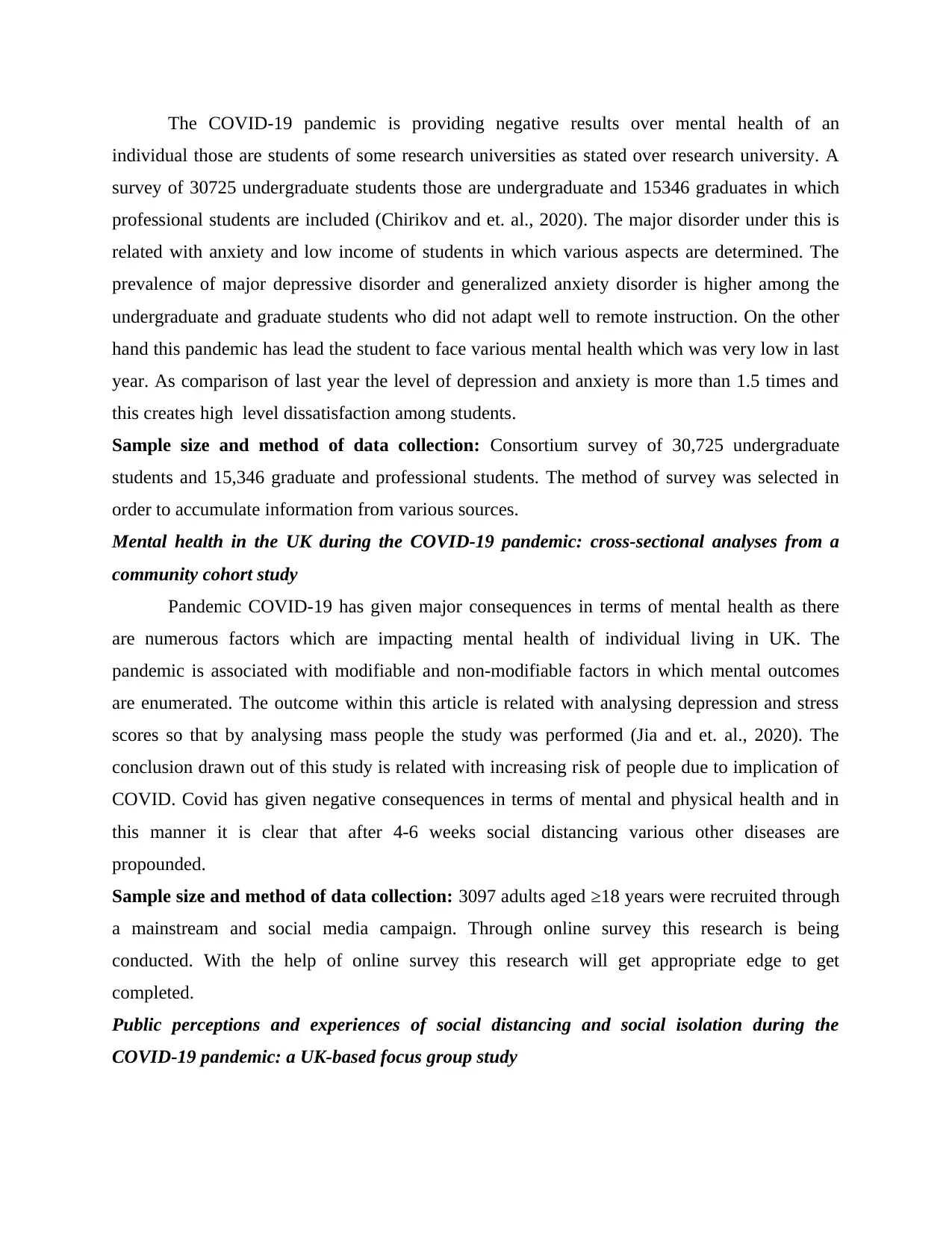
The COVID-19 pandemic is providing negative results over mental health of an
individual those are students of some research universities as stated over research university. A
survey of 30725 undergraduate students those are undergraduate and 15346 graduates in which
professional students are included (Chirikov and et. al., 2020). The major disorder under this is
related with anxiety and low income of students in which various aspects are determined. The
prevalence of major depressive disorder and generalized anxiety disorder is higher among the
undergraduate and graduate students who did not adapt well to remote instruction. On the other
hand this pandemic has lead the student to face various mental health which was very low in last
year. As comparison of last year the level of depression and anxiety is more than 1.5 times and
this creates high level dissatisfaction among students.
Sample size and method of data collection: Consortium survey of 30,725 undergraduate
students and 15,346 graduate and professional students. The method of survey was selected in
order to accumulate information from various sources.
Mental health in the UK during the COVID-19 pandemic: cross-sectional analyses from a
community cohort study
Pandemic COVID-19 has given major consequences in terms of mental health as there
are numerous factors which are impacting mental health of individual living in UK. The
pandemic is associated with modifiable and non-modifiable factors in which mental outcomes
are enumerated. The outcome within this article is related with analysing depression and stress
scores so that by analysing mass people the study was performed (Jia and et. al., 2020). The
conclusion drawn out of this study is related with increasing risk of people due to implication of
COVID. Covid has given negative consequences in terms of mental and physical health and in
this manner it is clear that after 4-6 weeks social distancing various other diseases are
propounded.
Sample size and method of data collection: 3097 adults aged ≥18 years were recruited through
a mainstream and social media campaign. Through online survey this research is being
conducted. With the help of online survey this research will get appropriate edge to get
completed.
Public perceptions and experiences of social distancing and social isolation during the
COVID-19 pandemic: a UK-based focus group study
individual those are students of some research universities as stated over research university. A
survey of 30725 undergraduate students those are undergraduate and 15346 graduates in which
professional students are included (Chirikov and et. al., 2020). The major disorder under this is
related with anxiety and low income of students in which various aspects are determined. The
prevalence of major depressive disorder and generalized anxiety disorder is higher among the
undergraduate and graduate students who did not adapt well to remote instruction. On the other
hand this pandemic has lead the student to face various mental health which was very low in last
year. As comparison of last year the level of depression and anxiety is more than 1.5 times and
this creates high level dissatisfaction among students.
Sample size and method of data collection: Consortium survey of 30,725 undergraduate
students and 15,346 graduate and professional students. The method of survey was selected in
order to accumulate information from various sources.
Mental health in the UK during the COVID-19 pandemic: cross-sectional analyses from a
community cohort study
Pandemic COVID-19 has given major consequences in terms of mental health as there
are numerous factors which are impacting mental health of individual living in UK. The
pandemic is associated with modifiable and non-modifiable factors in which mental outcomes
are enumerated. The outcome within this article is related with analysing depression and stress
scores so that by analysing mass people the study was performed (Jia and et. al., 2020). The
conclusion drawn out of this study is related with increasing risk of people due to implication of
COVID. Covid has given negative consequences in terms of mental and physical health and in
this manner it is clear that after 4-6 weeks social distancing various other diseases are
propounded.
Sample size and method of data collection: 3097 adults aged ≥18 years were recruited through
a mainstream and social media campaign. Through online survey this research is being
conducted. With the help of online survey this research will get appropriate edge to get
completed.
Public perceptions and experiences of social distancing and social isolation during the
COVID-19 pandemic: a UK-based focus group study
⊘ This is a preview!⊘
Do you want full access?
Subscribe today to unlock all pages.

Trusted by 1+ million students worldwide
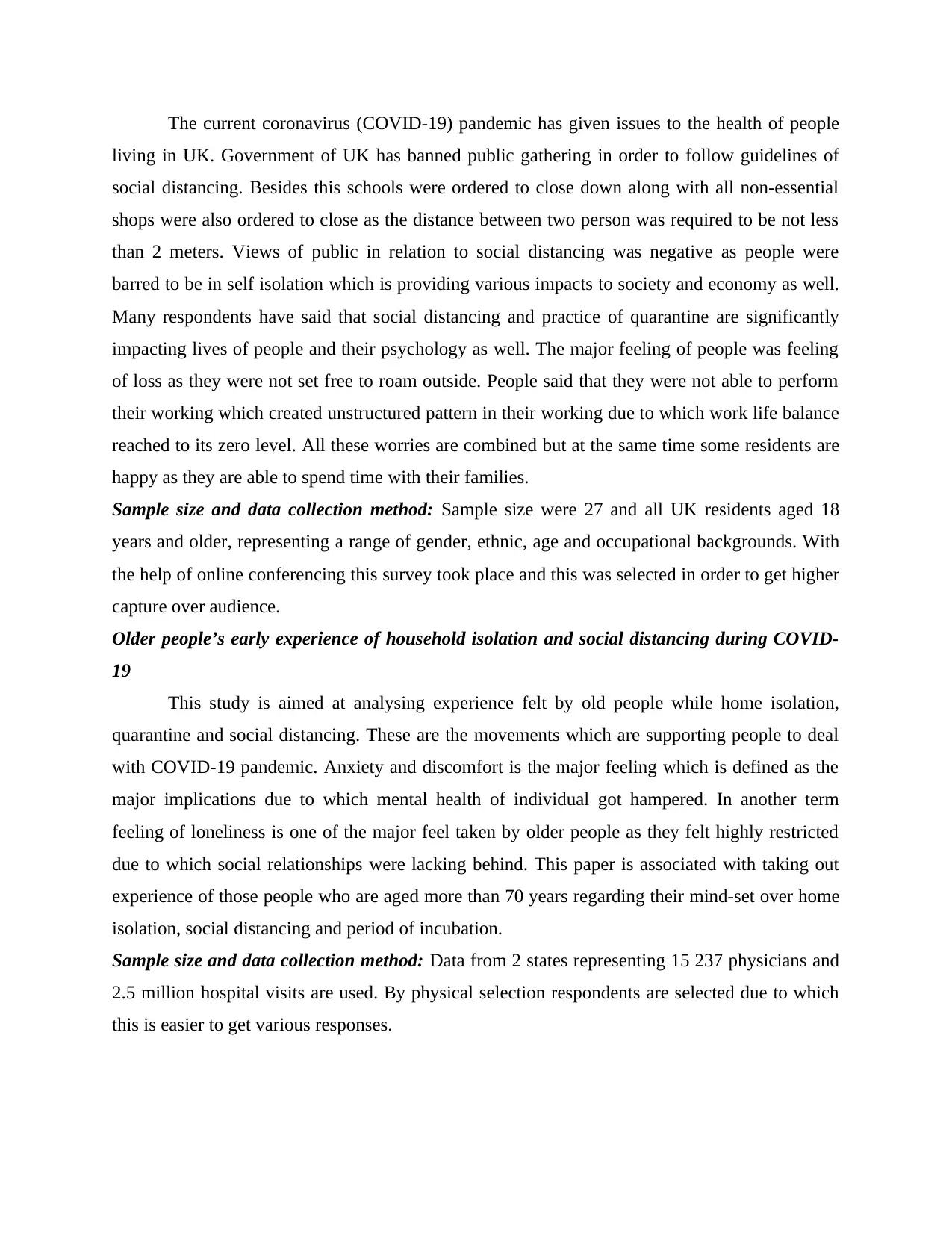
The current coronavirus (COVID-19) pandemic has given issues to the health of people
living in UK. Government of UK has banned public gathering in order to follow guidelines of
social distancing. Besides this schools were ordered to close down along with all non-essential
shops were also ordered to close as the distance between two person was required to be not less
than 2 meters. Views of public in relation to social distancing was negative as people were
barred to be in self isolation which is providing various impacts to society and economy as well.
Many respondents have said that social distancing and practice of quarantine are significantly
impacting lives of people and their psychology as well. The major feeling of people was feeling
of loss as they were not set free to roam outside. People said that they were not able to perform
their working which created unstructured pattern in their working due to which work life balance
reached to its zero level. All these worries are combined but at the same time some residents are
happy as they are able to spend time with their families.
Sample size and data collection method: Sample size were 27 and all UK residents aged 18
years and older, representing a range of gender, ethnic, age and occupational backgrounds. With
the help of online conferencing this survey took place and this was selected in order to get higher
capture over audience.
Older people’s early experience of household isolation and social distancing during COVID‐
19
This study is aimed at analysing experience felt by old people while home isolation,
quarantine and social distancing. These are the movements which are supporting people to deal
with COVID-19 pandemic. Anxiety and discomfort is the major feeling which is defined as the
major implications due to which mental health of individual got hampered. In another term
feeling of loneliness is one of the major feel taken by older people as they felt highly restricted
due to which social relationships were lacking behind. This paper is associated with taking out
experience of those people who are aged more than 70 years regarding their mind-set over home
isolation, social distancing and period of incubation.
Sample size and data collection method: Data from 2 states representing 15 237 physicians and
2.5 million hospital visits are used. By physical selection respondents are selected due to which
this is easier to get various responses.
living in UK. Government of UK has banned public gathering in order to follow guidelines of
social distancing. Besides this schools were ordered to close down along with all non-essential
shops were also ordered to close as the distance between two person was required to be not less
than 2 meters. Views of public in relation to social distancing was negative as people were
barred to be in self isolation which is providing various impacts to society and economy as well.
Many respondents have said that social distancing and practice of quarantine are significantly
impacting lives of people and their psychology as well. The major feeling of people was feeling
of loss as they were not set free to roam outside. People said that they were not able to perform
their working which created unstructured pattern in their working due to which work life balance
reached to its zero level. All these worries are combined but at the same time some residents are
happy as they are able to spend time with their families.
Sample size and data collection method: Sample size were 27 and all UK residents aged 18
years and older, representing a range of gender, ethnic, age and occupational backgrounds. With
the help of online conferencing this survey took place and this was selected in order to get higher
capture over audience.
Older people’s early experience of household isolation and social distancing during COVID‐
19
This study is aimed at analysing experience felt by old people while home isolation,
quarantine and social distancing. These are the movements which are supporting people to deal
with COVID-19 pandemic. Anxiety and discomfort is the major feeling which is defined as the
major implications due to which mental health of individual got hampered. In another term
feeling of loneliness is one of the major feel taken by older people as they felt highly restricted
due to which social relationships were lacking behind. This paper is associated with taking out
experience of those people who are aged more than 70 years regarding their mind-set over home
isolation, social distancing and period of incubation.
Sample size and data collection method: Data from 2 states representing 15 237 physicians and
2.5 million hospital visits are used. By physical selection respondents are selected due to which
this is easier to get various responses.
Paraphrase This Document
Need a fresh take? Get an instant paraphrase of this document with our AI Paraphraser
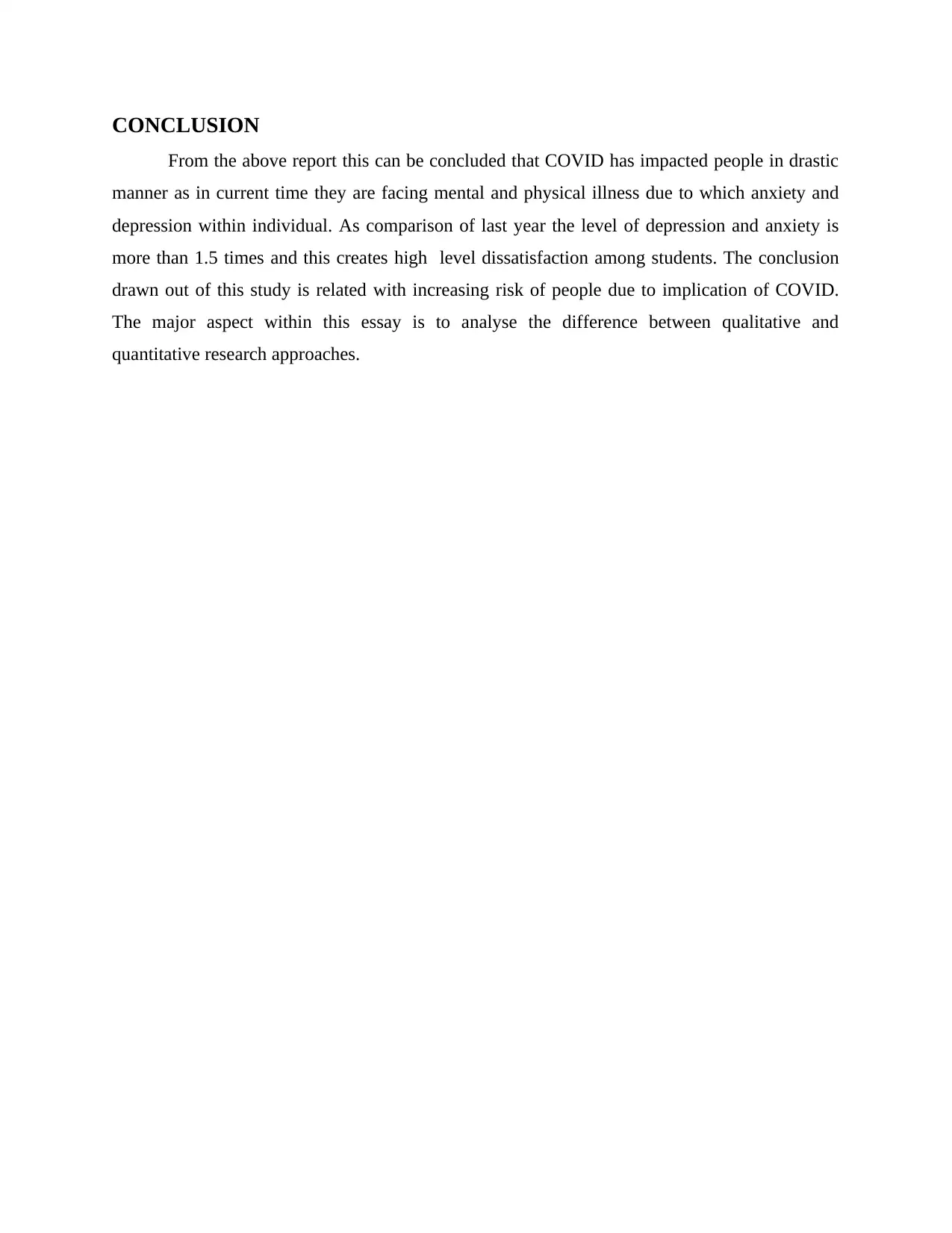
CONCLUSION
From the above report this can be concluded that COVID has impacted people in drastic
manner as in current time they are facing mental and physical illness due to which anxiety and
depression within individual. As comparison of last year the level of depression and anxiety is
more than 1.5 times and this creates high level dissatisfaction among students. The conclusion
drawn out of this study is related with increasing risk of people due to implication of COVID.
The major aspect within this essay is to analyse the difference between qualitative and
quantitative research approaches.
From the above report this can be concluded that COVID has impacted people in drastic
manner as in current time they are facing mental and physical illness due to which anxiety and
depression within individual. As comparison of last year the level of depression and anxiety is
more than 1.5 times and this creates high level dissatisfaction among students. The conclusion
drawn out of this study is related with increasing risk of people due to implication of COVID.
The major aspect within this essay is to analyse the difference between qualitative and
quantitative research approaches.
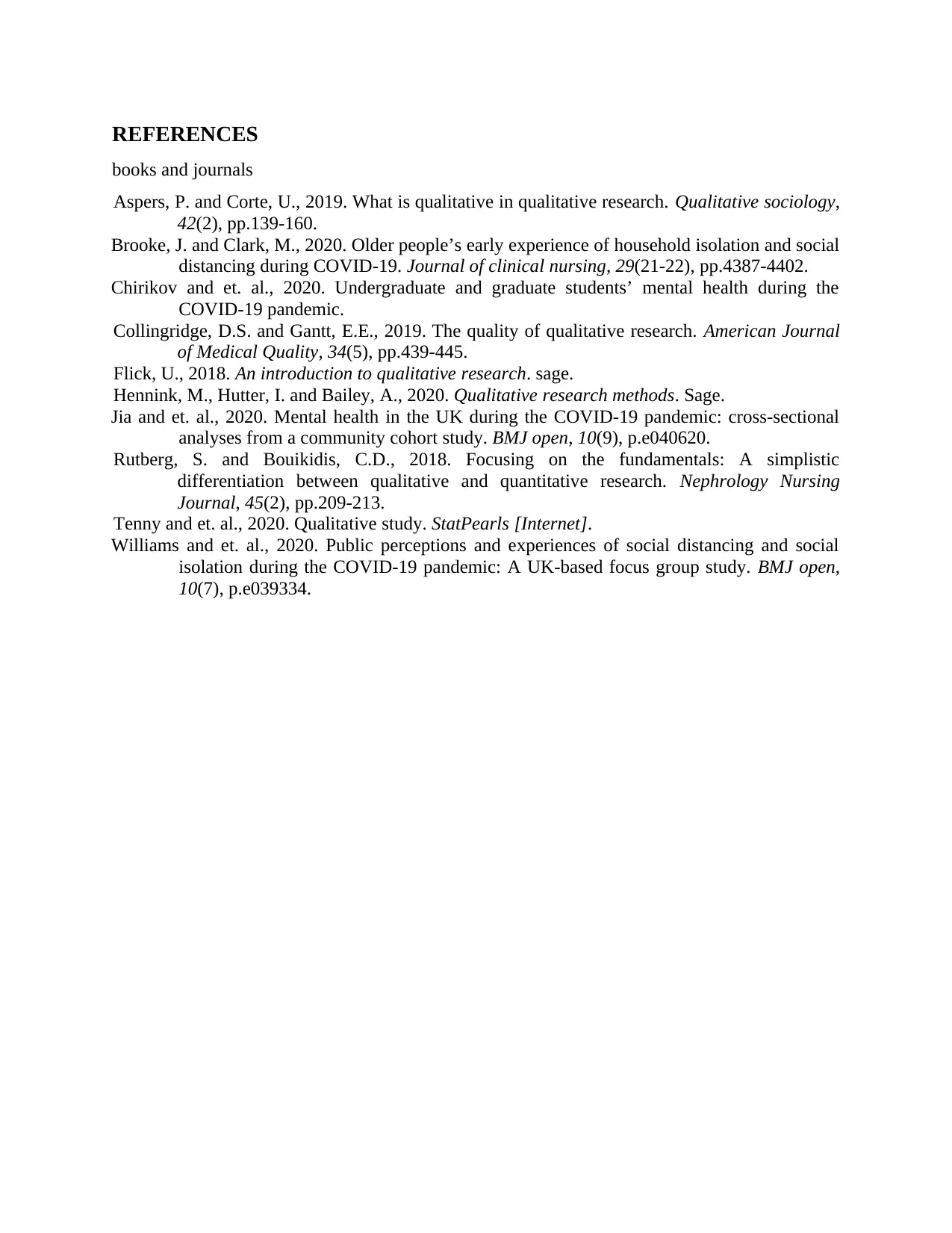
REFERENCES
books and journals
Aspers, P. and Corte, U., 2019. What is qualitative in qualitative research. Qualitative sociology,
42(2), pp.139-160.
Brooke, J. and Clark, M., 2020. Older people’s early experience of household isolation and social
distancing during COVID‐19. Journal of clinical nursing, 29(21-22), pp.4387-4402.
Chirikov and et. al., 2020. Undergraduate and graduate students’ mental health during the
COVID-19 pandemic.
Collingridge, D.S. and Gantt, E.E., 2019. The quality of qualitative research. American Journal
of Medical Quality, 34(5), pp.439-445.
Flick, U., 2018. An introduction to qualitative research. sage.
Hennink, M., Hutter, I. and Bailey, A., 2020. Qualitative research methods. Sage.
Jia and et. al., 2020. Mental health in the UK during the COVID-19 pandemic: cross-sectional
analyses from a community cohort study. BMJ open, 10(9), p.e040620.
Rutberg, S. and Bouikidis, C.D., 2018. Focusing on the fundamentals: A simplistic
differentiation between qualitative and quantitative research. Nephrology Nursing
Journal, 45(2), pp.209-213.
Tenny and et. al., 2020. Qualitative study. StatPearls [Internet].
Williams and et. al., 2020. Public perceptions and experiences of social distancing and social
isolation during the COVID-19 pandemic: A UK-based focus group study. BMJ open,
10(7), p.e039334.
books and journals
Aspers, P. and Corte, U., 2019. What is qualitative in qualitative research. Qualitative sociology,
42(2), pp.139-160.
Brooke, J. and Clark, M., 2020. Older people’s early experience of household isolation and social
distancing during COVID‐19. Journal of clinical nursing, 29(21-22), pp.4387-4402.
Chirikov and et. al., 2020. Undergraduate and graduate students’ mental health during the
COVID-19 pandemic.
Collingridge, D.S. and Gantt, E.E., 2019. The quality of qualitative research. American Journal
of Medical Quality, 34(5), pp.439-445.
Flick, U., 2018. An introduction to qualitative research. sage.
Hennink, M., Hutter, I. and Bailey, A., 2020. Qualitative research methods. Sage.
Jia and et. al., 2020. Mental health in the UK during the COVID-19 pandemic: cross-sectional
analyses from a community cohort study. BMJ open, 10(9), p.e040620.
Rutberg, S. and Bouikidis, C.D., 2018. Focusing on the fundamentals: A simplistic
differentiation between qualitative and quantitative research. Nephrology Nursing
Journal, 45(2), pp.209-213.
Tenny and et. al., 2020. Qualitative study. StatPearls [Internet].
Williams and et. al., 2020. Public perceptions and experiences of social distancing and social
isolation during the COVID-19 pandemic: A UK-based focus group study. BMJ open,
10(7), p.e039334.
⊘ This is a preview!⊘
Do you want full access?
Subscribe today to unlock all pages.

Trusted by 1+ million students worldwide
1 out of 9
Related Documents
Your All-in-One AI-Powered Toolkit for Academic Success.
+13062052269
info@desklib.com
Available 24*7 on WhatsApp / Email
![[object Object]](/_next/static/media/star-bottom.7253800d.svg)
Unlock your academic potential
Copyright © 2020–2025 A2Z Services. All Rights Reserved. Developed and managed by ZUCOL.





